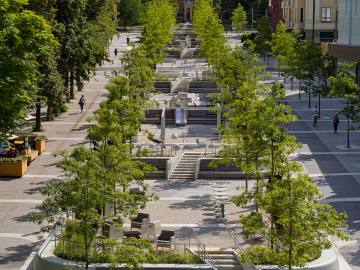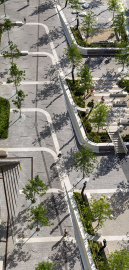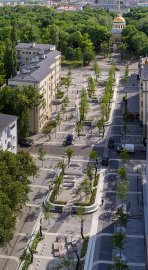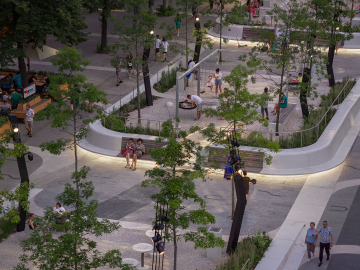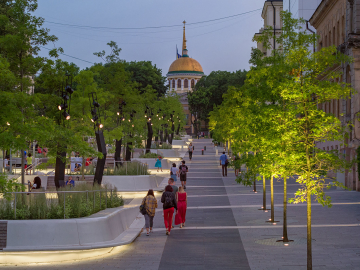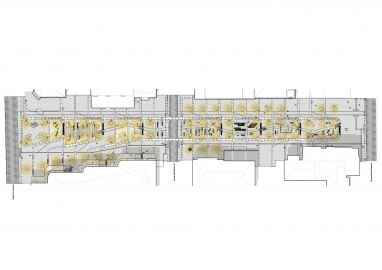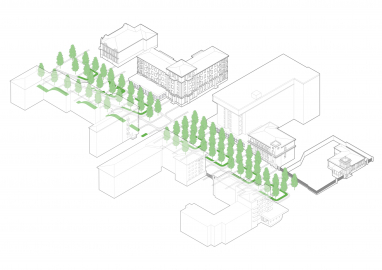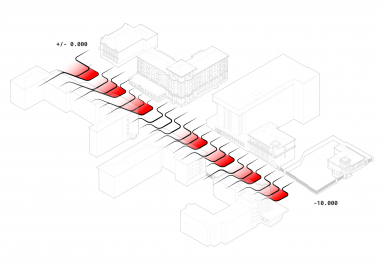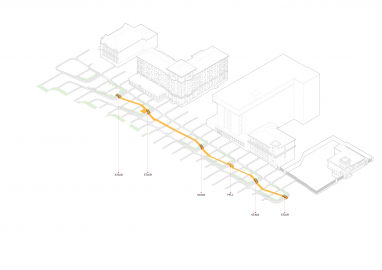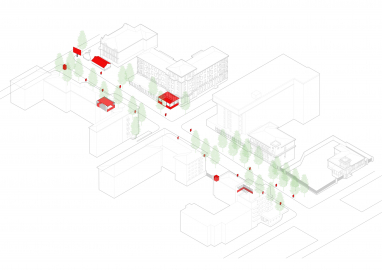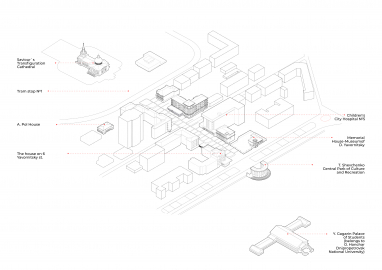Reconstruction of Yavornitsky Street
The project of transformation one of the oldest streets in the city from car-oriented to pedestrian. Thanks to urban development funds the project connects two existing torn pedestrian spaces - a square and a park into a single pedestrian system setting the vector of environmental development for the entire city.
The projected street is a place with a huge historical background. Being at the top of the central city hill, it was conceived as one of the first urban planning axes of the city, and later visually connected the symbolic objects of different eras of the city's development - the central Orthodox church, the entrance zone of the main park, post-industrial sculpture and new symbols of an independent country.
Before the reconstruction, the street came in the form of a car street with an excess of chaotic parking and was used exclusively as a transit space. The project restores the originally laid down town-planning sense and the mental spirit of the street, creates a completely pedestrian modern space consonant with the spirit of the pre-revolutionary empire.
The main conceptual idea of the visual image is the waves of the Dnipro River. Bending around the hill where the object is located, waves are the main identity of the city.
Falling along the relief, these waves form seven terraces, each of which has its own main theme - a meeting place, a garden terrace, an art performance area, an active children's area, an area for intellectual quiet games, a sun deck, a communication area. All these spaces are united by lateral walking links as well as by a central, broken, metaphysical path that successively penetrates the terraces through stairs and a children's slide. This path is a kind of game: if a visitor wants to go all the way and fully discover the diversity of street spaces, for a moment he must turn into a child and slide down the hill. This technique allows you to create a pleasant, festive and informal mood on the street.
This configuration of the environment activates cross-links, slows down pedestrian transit and invites you to stay in the street space.
There was no concept of inclusiveness in the Soviet Union. The street environment was focused on the comfort of road transport, and design standards were drawn up accordingly. As the heirs of that era, we are faced with the problem of goal-setting in the street environment.
Therefore, the global challenge of the project is the creation of a precedent for a human-centered space in the city, barrier-free and working for all social groups of users.
These tasks have been accomplished in various ways. For instance, by organizing the movement of pedestrians continuously in the same level without drops and steps. The priority of pedestrians is emphasized by the pavement at intersections with car traffic. The project does not end with the design boundary but flows smoothly, interacts, and also lays down the scenario for the development of the surrounding street network. Due to such a structure of space and filling with outdoor furniture, we avoid social distancing to the required extent. Each social stratum finds a place and occupation for itself. At the same time young, adults, elderly people and children constantly mix with each other, communicate and interact.
The concept of falling waves is realized due to the retaining walls of the terraces, smoothly turning into the paving pattern and forming the visual frame of the composition. The elements of this frame are made of white architectural concrete, produced in a local factory and pre-assembled on site. The frame is filled with a contrasting coating.
In coating materials, it was very important to maintain a hard / soft balance.
Hard. The transit routes are made of local granite, a material that carries the city's identity. Due to different processing, one type of granite acquired a different color and texture, from which the paving pattern was formed. The bike paths are marked with stainless steel beads. This technology was used in the country for the first time for these tasks.
Soft. The interior spaces of the terraces are covered with soft stone chips which together with the spreading bushes, tactilely create a calm and unhurried atmosphere in these areas.
Outdoor furniture is made of galvanized steel and untreated thermowood. Materials that age honestly and beautifully.

